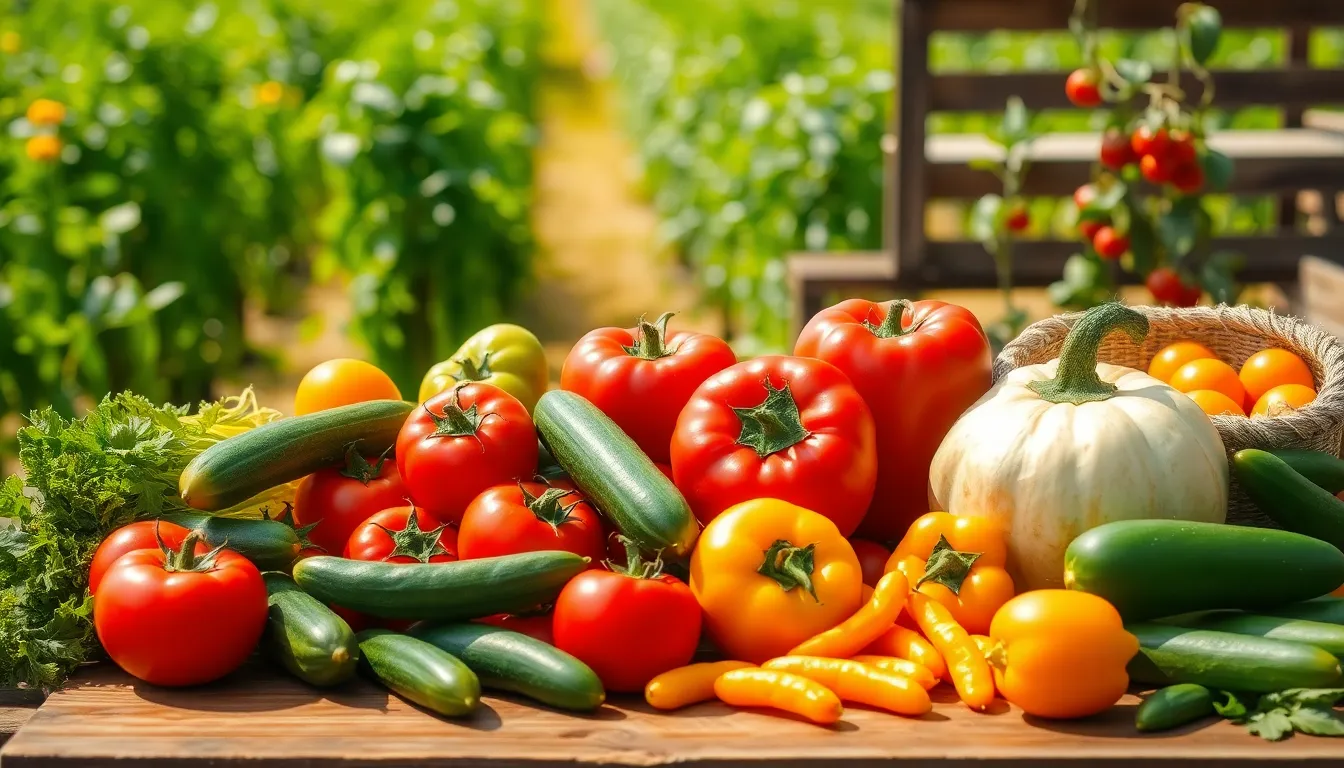In a world where the journey from farm to table is often lost amid processed foods and takeout menus, embracing farm to table recipes feels like a delicious rebellion. Imagine biting into a juicy tomato that’s still warm from the sun or savoring a salad made with greens picked just hours before. It’s not just food; it’s a vibrant experience that connects diners to the land and the hardworking farmers who cultivate it.
Farm to table isn’t just a trend; it’s a lifestyle that celebrates freshness and flavor. These recipes invite everyone to roll up their sleeves and get a little dirt under their nails, all while whipping up mouthwatering dishes that’ll impress even the pickiest eaters. So grab your apron and let’s dive into the delightful world of farm to table cooking—where the only thing fresher than the ingredients is the laughter shared around the table.
Farm To Table Recipes
Farm to table recipes focus on utilizing seasonal, locally sourced ingredients. Chefs and home cooks create dishes that showcase the flavors and freshness of produce. This approach reduces the carbon footprint associated with transporting food long distances. Communities often benefit from these practices as they support local farmers and artisans.
Inspiration for farm to table recipes can come from farmers’ markets, community-supported agriculture, or backyard gardens. Ingredients often vary based on the season, encouraging creativity in the kitchen. Fresh basil, ripe strawberries, and crisp cucumbers represent some produce options that can be incorporated into meals.
Vegetables play a significant role in these recipes, providing vital nutrients and vibrant colors. Authentic flavors shine through when using fresh ingredients, as they require minimal processing. Preparation techniques often emphasize simplicity to highlight the essential tastes of the ingredients.
Farm to table cooking encourages a mindful dining experience. Diners connect with the source of their food, fostering appreciation for local ecosystems. Recipes often include a variety of dishes, such as salads, soups, and grilled meats, showcasing ingredients’ versatility.
Creating meals using farm to table methods not only supports health but also strengthens community ties. Participating in local food systems can inspire others to explore sustainable practices. Engaging in this culinary lifestyle contributes to overall well-being, making each meal an opportunity for celebration.
Benefits of Farm to Table Cooking

Farm to table cooking offers numerous benefits that enhance the culinary experience. Fresh, local ingredients lead to improved nutrition and flavor.
Healthier Meal Options
Utilizing seasonal produce ensures meals are at their peak freshness. Authentic flavors come from vibrant vegetables, which often have higher nutrient content when sourced locally. Eating farm to table reduces exposure to preservatives and chemicals commonly found in processed foods. Accessing fresh ingredients means meals are richer in essential vitamins and minerals. Families enjoy dishes that not only satisfy hunger but also nourish the body. Seasonal recipes encourage variety, helping to diversify diets. Healthier choices with whole foods support overall well-being.
Supporting Local Farmers
Choosing farm to table helps sustain local economies. By purchasing directly from farmers, individuals contribute to their livelihoods and community growth. Strengthening local agriculture fosters biodiversity and reduces the carbon footprint from transportation. Connecting with local farmers cultivates a sense of trust and accountability in food sourcing. Supporting regional farms enhances the resilience of communities by ensuring food security. Building relationships with farmers allows for greater transparency in food production practices. Encouragement of local food systems aids in retaining cultural and culinary traditions.
Essential Ingredients for Farm to Table Recipes
Farm to table cooking prioritizes fresh, local ingredients that enhance flavor and nutrition. Essential components include fresh produce and organic proteins.
Fresh Produce
Seasonal fruits and vegetables form the backbone of farm to table recipes. Heirloom tomatoes, sweet corn, and vibrant greens offer intense flavors and colors. Picked at peak ripeness, seasonal produce provides the highest nutrient content. Local farmers’ markets supply a diverse array of ingredients, allowing creativity in meal preparation. Ingredients often include asparagus in spring or squash in autumn, reflecting the changing seasons. Incorporating these fresh vegetables and fruits makes dishes not only healthier but also more visually appealing.
Organic Proteins
Organic proteins play a vital role in farm to table cooking. Grass-fed beef, free-range chicken, and sustainably sourced fish support both health and ethical eating choices. Freshly raised livestock often contains more omega-3 fatty acids and fewer hormones compared to conventional meat. Choosing organic options aligns with the philosophy of supporting local farmers and reducing environmental impact. Ingredients such as pasture-raised eggs or heritage breed pork offer unique flavors that elevate dishes. Incorporating these organic proteins into recipes helps create satisfying and nutritious meals.
Popular Farm to Table Recipes
Farm to table recipes highlight the exceptional flavors of seasonal ingredients. These recipes maximize freshness and nutritional value, creating delicious meals that honor local agriculture.
Seasonal Salads
Locally sourced greens serve as the foundation for vibrant salads. Heirloom tomatoes add color and sweetness, while crisp cucumbers provide crunch. Seasonal ingredients like snap peas and radishes enhance textures, making each bite exciting. A drizzle of homemade vinaigrette elevates the dish, showcasing the natural flavors of the fresh produce. Engaging in farmers’ markets ensures access to the best seasonal ingredients, inspiring creative combinations that delight the palate.
Hearty Soups
Fresh vegetables transform basic soups into nourishing meals. Ingredients like squash and carrots bring warmth, while seasonal herbs add depth of flavor. Using organic chicken or vegetable broth strengthens the dish’s comfort factor, ensuring every spoonful offers satisfaction. Homemade soups benefit from slow simmering, allowing flavors to meld and develop richness. Experimenting with local ingredients creates unique variations that highlight the essence of farm to table cooking.
Grilled Vegetables
Grilling season brings out the best in vegetables, infusing them with smoky flavor. Zucchini and bell peppers shine when charred, enhancing their natural sweetness. Seasonal corn kernels pop with juiciness, making them a fantastic addition to summer dishes. A sprinkle of sea salt and a squeeze of lemon enhance the vibrant flavors and aromas. Preparing grilled vegetables as a side or main dish not only supports local farms but also encourages diners to savor the simple pleasures of fresh, seasonal produce.
Tips for Creating Farm to Table Meals
Sourcing local ingredients plays a crucial role in farm to table cooking. Connecting with local farmers ensures access to fresh produce and meats that are in season. Visiting farmers’ markets offers a variety of options where shoppers can select ingredients straight from the source. Establishing relationships with farmers provides insight into growing practices and seasonal variations. Community-supported agriculture (CSA) programs also provide excellent ways to receive fresh, local produce regularly.
Meal planning and preparation enhance the farm to table experience. Developing a weekly menu based on seasonal ingredients encourages creativity and reduces food waste. Preparing simple dishes allows the vibrant flavors of fresh produce to shine through. It’s important to keep pantry staples on hand, such as olive oil and herbs, to complement locally sourced ingredients. Organizing cooking sessions with family or friends fosters a communal cooking spirit. Embracing flexibility in recipes invites experimentation with varied ingredients, leading to unique meal creations.
Conclusion
Embracing farm to table cooking transforms not just meals but the entire dining experience. By prioritizing fresh, local ingredients, individuals can enjoy enhanced flavors while supporting their community and the environment. This approach fosters a deeper connection to food and its origins, leading to healthier choices and more meaningful meals shared with loved ones.
As they explore the vibrant world of seasonal produce and organic proteins, home cooks can unleash their creativity in the kitchen. Each dish becomes an opportunity to celebrate the bounty of local farms and the joy of cooking. Farm to table isn’t just a trend; it’s a lifestyle that enriches both the palate and the community.

